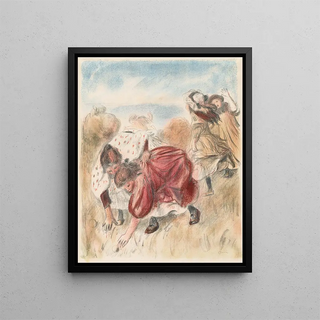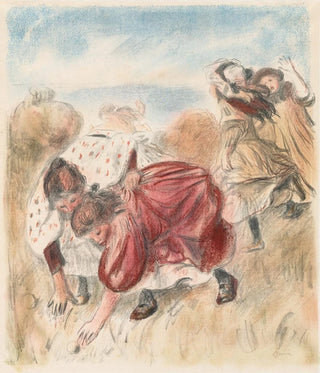Art print | Children playing with a ball - Pierre-Auguste Renoir Source: Reproduction | Enfants jouant au ballon - Pierre-Auguste Renoir


View from behind

Frame (optional)
In the vibrant world of Impressionism, the art print "Children Playing with a Ball" by Pierre-Auguste Renoir stands out for its ability to capture the lightness and innocence of childhood. Painted in 1876, this canvas evokes a fleeting moment of pure joy, where children indulge in a simple yet emotionally charged game. The scene, bathed in light and vivid colors, invites the viewer to share in this playful experience, to feel the happiness emanating from this innocent interaction. The art print Children Playing with a Ball - Pierre-Auguste Renoir thus allows for a rediscovery of the very essence of childhood, while offering a glimpse into the artist's technical mastery.
Style and uniqueness of the work
Renoir's style is characterized by a bold approach to colors and a particular attention to light. In "Children Playing with a Ball," he uses fluid and dynamic brushstrokes to create an atmosphere of movement and vitality. The faces of the children, delicately modeled, are illuminated by a soft light that seems to caress their skin. Renoir excels in depicting textures, whether through the children's clothing or the surrounding landscape. This canvas, while rooted in touching realism, transcends simple representation to become an ode to the joy of living. The composition, balanced and harmonious, draws the eye toward the center of the scene, where the ball becomes a symbol of carefree innocence and friendship.
The artist and his influence
Pierre-Auguste Renoir, an emblematic figure of Impressionism, managed to mark his era with his unique style and artistic vision. Born in 1841, he was initially influenced by the masters of the past but quickly found his own voice, focusing on the beauty of everyday life and human interactions. Renoir was able to capture emotion in his works, making each canvas a window into the human soul. His influence extends far beyond his time, inspiring generations of artists to explore themes of light, color, and daily life. His ability to immortalize simple yet meaningful moments

Matte finish

View from behind

Frame (optional)
In the vibrant world of Impressionism, the art print "Children Playing with a Ball" by Pierre-Auguste Renoir stands out for its ability to capture the lightness and innocence of childhood. Painted in 1876, this canvas evokes a fleeting moment of pure joy, where children indulge in a simple yet emotionally charged game. The scene, bathed in light and vivid colors, invites the viewer to share in this playful experience, to feel the happiness emanating from this innocent interaction. The art print Children Playing with a Ball - Pierre-Auguste Renoir thus allows for a rediscovery of the very essence of childhood, while offering a glimpse into the artist's technical mastery.
Style and uniqueness of the work
Renoir's style is characterized by a bold approach to colors and a particular attention to light. In "Children Playing with a Ball," he uses fluid and dynamic brushstrokes to create an atmosphere of movement and vitality. The faces of the children, delicately modeled, are illuminated by a soft light that seems to caress their skin. Renoir excels in depicting textures, whether through the children's clothing or the surrounding landscape. This canvas, while rooted in touching realism, transcends simple representation to become an ode to the joy of living. The composition, balanced and harmonious, draws the eye toward the center of the scene, where the ball becomes a symbol of carefree innocence and friendship.
The artist and his influence
Pierre-Auguste Renoir, an emblematic figure of Impressionism, managed to mark his era with his unique style and artistic vision. Born in 1841, he was initially influenced by the masters of the past but quickly found his own voice, focusing on the beauty of everyday life and human interactions. Renoir was able to capture emotion in his works, making each canvas a window into the human soul. His influence extends far beyond his time, inspiring generations of artists to explore themes of light, color, and daily life. His ability to immortalize simple yet meaningful moments






